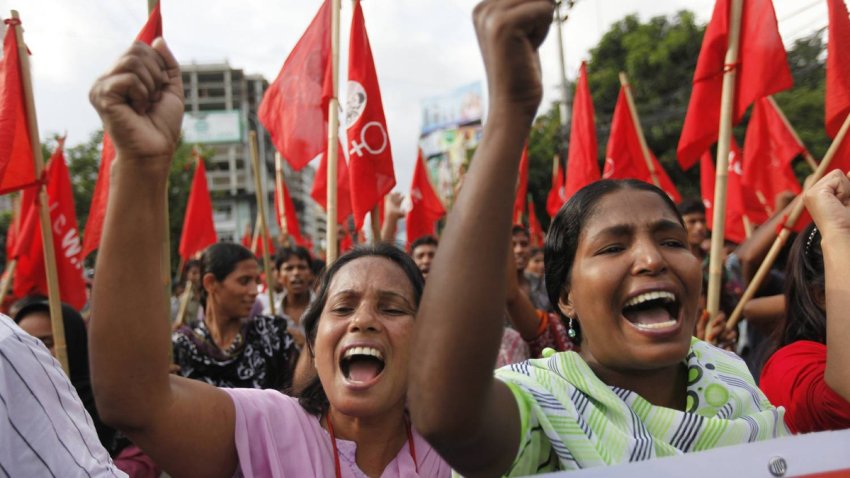
Rosina Atker arrived to work as usual with her mother and sister at 8am on April 24, 2013, but she would never go home.
Rosina, a garment worker in the Rana Plaza building, was four months pregnant. When they arrived at work, her sister asked the manager if they could go home; the building seemed unsafe, everyone could see the cracks in the walls. They were told “not to worry and to keep working”.
In fact, local authorities had recommended the previous day that all factory operations be suspended. Bank and shop employees on the lower floors had been told to stay home. But the garment workers were forced to remain under threat of dismissal.
Just a few hours later, the building would collapse, trapping hundreds of workers inside. Rosina was one of more than 1100 people killed.
The Rana Plaza disaster unveiled to the world the true cost of the fashion industry’s contempt for workers’ rights.
Soon, it emerged that the collapse had been preventable. The weight of the machines and staff was more than six times what the building was meant to bear.
The danger had been wilfully ignored, not just by the factory bosses but by the fashion brands that audited the building.
A wave of outrage encircled the globe. More than 1 million people marched, protested and signed petitions. War on Want worked with union partners on the ground to push for compensation for the families of those injured and killed in the collapse and to mobilise people in Britain.
Under enormous public pressure, more than 150 major brands and retailers joined a union-led initiative called the Bangladesh Safety Accord.
The Accord was a groundbreaking tripartite agreement between government, corporations and workers. It was the first time that the brands and retailers making billions on the backs of garment workers agreed to deal with them collectively.
By February 2014, the Accord covered 1600 factories. These were now legally bound to independent and transparent inspections, financing mandatory repairs, and allowing workers to refuse unsafe work, access a union and take collective action when safety standards were not met.
Each point in the Accord represented a historic turn away from the industry’s abysmal record of impotent voluntary agreements and secretive self-assessment.
Yet the sight of their clothes strewn over a broken concrete graveyard was not enough to convince everyone. Some brands, such as GAP and Asda’s parent company Walmart, refused to join.
Instead, they promoted their own rival initiative: a plan based on the old voluntary approach, focusing on corporate responsibility instead of workers’ rights. That is, the same system that failed Rosina, her unborn child and the 3600 others killed or injured when Rana Plaza collapsed.
They were not alone: the British government led the European Union nations opposed to a binding treaty.
In January, unions representing Bangladeshi garment workers reached a US$2.3 million settlement with an anonymous multinational fashion brand over delays to fixing safety hazards in its factories.
Five years after the Accord was introduced, it has shown its worth. The union has proven it is possible to translate the Accord into action that saves lives.
Still, it took a two-year fight to win that settlement. This also reflects an important truth: agreements will never be enough without the workers’ right to organise and fight to defend their lives and livelihoods.
That goal remains a long way off. In Bangladesh, the Accord has made factories safer, but the right to form and join unions or go on strike is still met with brutal suppression.
Last year, thousands of workers took to the streets to demand their pay be doubled to bring them closer to a living wage.
They were met with arrests and prosecutions, with thousands of workers blacklisted by the industry.
Wages in the Bangladeshi garment industry remain too low to cover basic costs. Overtime is still routinely forced on workers, who still have no right to a union.
Workers have responded innovatively to the challenge. Where the right to form a union is denied, the occupational health and safety workplace committees introduced by the Accord have been used as an entry point for workers to start organising and a basis for trade union formation.
With fashion brands making billions in profit every year, the idea that respect for basic labour and human rights should be optional is a disgrace. The Accord was an important step away from that and January’s settlement shows that it can be used to make companies pay for endangering their workers’ lives.
But when it comes to putting people before profit, whether in health and safety or in a fair day’s pay, companies will always strive to protect their bottom line.
That is why the Accord alone will not protect workers. It is worth as much as the worker on the factory floor who holds it and has the right to organise for dignity and justice.
[Slightly abridged from Red Pepper.]